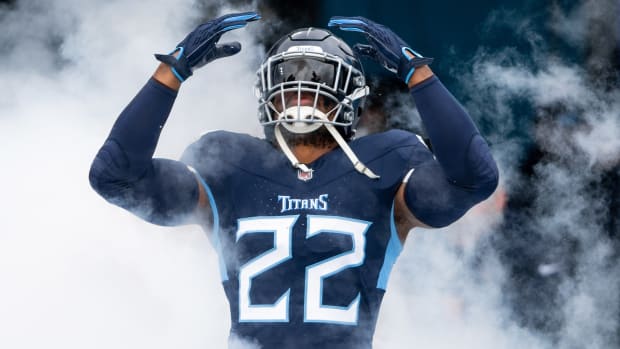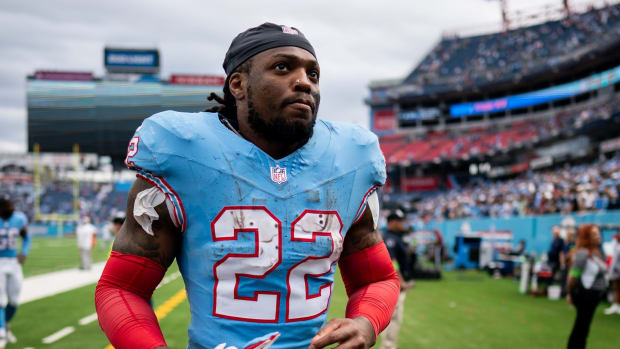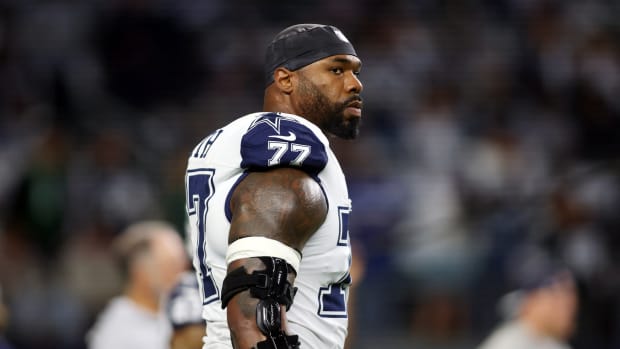Five Ways the Defense is Better in 2021
NASHVILLE – Had the Buffalo Bills punched in a game-winning touchdown in the closing seconds Monday, Tennessee Titans fans understandably might have bemoaned the state of the team’s defense, wondering why 34 points wasn’t enough to record a victory.
That never happened.
The defense rose up and stuffed the high-powered Bills on three straight plays inside the 10-yard line, clinching a victory over one of the NFL’s hottest teams.
Is that an indication the Titans’ much-maligned `D’ is well on its way to making itself over after last year’s horrid performance?
Not quite. There’s still plenty of room for improvements in departments like points allowed, touchdown passes surrendered and takeaways.
But it’s worth noting that the unit, which was overhauled in the offseason, has taken steps forward in a number of ways through the first six games. They’ve done so despite outside linebacker Bud Dupree performing at less than 100 percent and injuries to key performers like safety Amani Hooker, linebacker Jayon Brown, and cornerbacks Kristian Fulton and Caleb Farley.
Where have the Titans’ defensive strides from 2020 to 2021 been most noticeable?
Here are five categories that fit the bill:
• Third-down performance – This was without question the biggest offseason emphasis after the defense allowed opponents to convert an NFL-worst 52 percent of third-down attempts last season. So far, the Titans have seen all that work pay off to a degree. Opponents have converted 40.5 percent of their third-down attempts, which ranks 15th in the NFL.
The best third-down performance of the season came against Indianapolis, when Tennessee held the Colts to just three conversions in 12 attempts, a 25 percent success rate.
“Probably covering better and rushing better,” coach Mike Vrabel said when asked about the improvement. “I don’t know how else to answer it. Those are the two elements that we talk about all the time, covering better and rushing better. Hopefully we can continue to do that.”
• Red-zone stops – If improvement on third-down was the top priority during the past offseason then improving the red-zone defense wasn’t too far behind. As recently as 2018, the Titans finished second in the NFL in this category, allowing opponents to score touchdowns just 44.7 percent of the time they reached Tennessee’s 20. But in 2019 and 2020, the Titans all but rolled out the red carpet in the red zone, allowing opponents to score red-zone touchdowns at a 63.2 percent clip in 2019 (ranking 28th in the NFL) and dropping to 67.7 percent last year (30th).
As evidenced by the performance against the Bills, things have gotten much better. Tennessee allowed Buffalo to score touchdowns on just two-of-five trips into the red zone and has allowed opponents to score red-zone touchdowns at a rate of 56 percent, which is 13th-best in the NFL.
“When you’re in the red zone, offenses definitely have different things – jets, quarterbacks lining up at wide receiver, all types of stuff,” inside linebacker Rashaan Evans said. “They can get really magical with it. But as a defense, you just want to have really good communication, everyone being keyed on their guy and doing their job. Most of the time, you have a good outcome that way.”
• Sacking the quarterback – Granted, there was a low bar for improving on last year’s sack total of 19, which ranked 30th in the league. That was an average of a mere 1.2 sacks per contest, and Harold Landry (5.5 sacks) was the only one with more than three.
The Titans aren’t necessarily terrorizing quarterbacks this year, but they already have 13 sacks, just six shy of last year’s total. That’s an average of 2.2 per game, an increase of a full sack per contest from 2020. Landry is the main reason for the jump, as his 6.5 sacks are tied for third in the NFL. The Titans have twice this season registered three-sack games – against Seattle’s Russell Wilson and Buffalo’s Josh Allen.
It’s not just a question of more opportunities resulting in more sacks either. The Titans’ sack percentage this season is 6.1 percent, up from 3.5 percent in 2020.
• Goal-to-go conversions – This is the area of the field where defenses make their final stands, hoping to force a field goal or a turnover on downs. The Titans didn’t exactly present a brick wall here last season either when they allowed opponents to score touchdowns 29 times in 35 attempts – an 82.9 percent conversion rate that ranked 26th in the NFL.
The game-saving fourth-down stop Simmons made against Allen in the closing seconds on Monday was more evidence of improvement. The Titans have limited opposing teams to 14 touchdowns in 25 goal-to-go situations, a 58.8 percent conversion rate that ranks sixth.
“You have to get it in your mind that you are going to stop them or make them kick field goals,” Simmons said. “It’s just a mindset we have on defense. You’ve got to defend every blade of grass. You’ve got to keep teams from out of the end zone. If they kick field goals, great. If they miss them, even greater.”
• Run defense – Wait a minute, you’re saying. Didn’t Jacksonville just run all over the Titans, piling up 198 yards on the ground – led by James Robinson’s total of 149 yards on 18 carries? This is true. But the Titans rebounded well on Monday. They limited the Bills, who entered the game fifth in the league in rushing (averaging 140.4 yards per game) to a season-low 82 yards on 23 carries. That marked the fourth time in six games that opponents finished with fewer than 100 rushing yards. The Cardinals were the only other team other than Jacksonville to hit triple digits.
Overall, the Titans are in the top 10 (ninth) with an average of 107.7 yards per game allowed on the ground. Last season they allowed 120.8 rushing yards per game, which ranked 19th. Part of the reason for the drop? The Titans have allowed only three runs of 20-plus yards this season, tied for 13th in the NFL.




